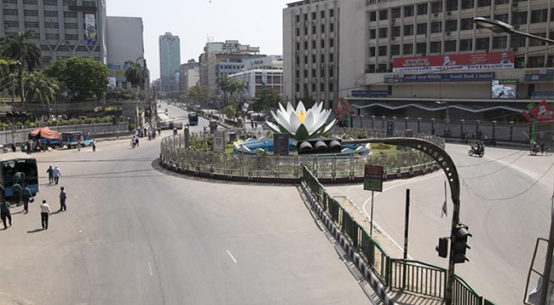A port is a maritime facility comprised of one or more wharves or loading areas where ships load and discharge cargoes and passengers. The port sector includes public and private marine facilities.
Globally, seaports serve as a vital link for many supply chains and distribution channels related to international trade, thereby playing an important role in economic development and creating significant sources of local employment.
In Bangladesh, seaports play a crucial role in the country’s economy and trade. Chittagong port is the main and oldest seaport in Bangladesh. Located in the southern part of the country, the port handles a majority of Bangladesh’s imports and exports, including raw materials, finished goods, and agricultural products. On the other hand, the port is also an important contributor to the country’s GDP and employment as it supports a range of industries, including shipping, logistics, and manufacturing. In addition to its economic importance, the port is also a key contributor to the country’s infrastructure as it plays a vital role in the development and maintenance of roads, rail lines, and other transportation networks. Chittagong port is thus considered as the lifeline of the national economy as 92% of export and import of Bangladesh is conducted through this port. The rest is carried out through Mongla and a few other river and land ports.
Chittagong port generates more than $30 billion each year. It also facilitates various developmental activities of the country that include shipbuilding, textiles, and chemicals, which rely on the port as a gateway to the export of their products. Along with Bangladesh, three other countries – India, Nepal, and Bhutan also use this port for transit. So, allowing these countries to use the port also brings huge revenue, which contributes toward the development of Bangladesh’s economy.
Many materials needed for ongoing megaprojects and industrial construction processes in Bangladesh are imported through this port. On the other hand, by exporting various products made in Bangladesh, this port is helping Bangladesh to increase foreign reserves.
In recent years, the government of Bangladesh has made significant investments in the port sector especially in Chittagong and Mongla ports to improve their capacity and efficiency.
Industrialisation
Apart from its role in facilitating trade, Chittagong port also supports the growth of industries. There has been a lot of industrial development in the surrounding areas of Chittagong port. These industries are mainly engaged in export-import business, and they are built near the port to reduce the cost of transportation. Chittagong port supports the country’s industries by working as a gateway to importing raw materials and other inputs needed for production. This helps to ensure that industries have easy access to resources they need to operate and grow. The port is a key link in the region’s transportation network, connecting Bangladesh to other countries in South and Southeast Asia. This helps to facilitate movement of goods and people, which in return support the growth of industries in the region.
It is noted here that the net income of Chittagong port was Tk 1,075 crore in Fiscal Year 2021-2022, according to the port officials. The average revenue is about 1.4% of average annual income of the country.
Mongla port is the second seaport of Bangladesh. It is a sheltered port handling most types of cargo, including vehicles, clinker, fertiliser, grain, coal, salt, LPG, edible oil and containers. In 2020, the port saw a turnout of 970 ships — the highest in its 70-year history. Mongla port authorities earned Tk 340 crore in the previous fiscal year, also highest in its 70-year history. It earned a profit of Tk 1.30 billion from a limited-scale operation.
In response to the country’s expanding needs, a modern, environmentally-friendly seaport is being created in South Bengal. Payra port’s operations began on November 19, 2013, with the prime minister unveiling the foundation stone.
Since its inception, the port has been conducting certain operational enterprises, including a restricted range of export- import activities. Revenue worth Tk 354 crore has been generated from the operation of 169 foreign merchant ships.
Payra Seaport Project will be generating a variety of jobs in EPZ, SEZ, ship-building and repair industries. The establishment of new industrial zones would provide employment to people in districts such as Barishal, Patuakhali and Bhola, which neighbour the port.
Employment Opportunity
Chittagong port has been a positive driver for employment, creating jobs for local population. Over 8,000 people work for Chittagong port. Of them, 31.9% works for the port and 33.3% for customs. Moreover, due to industrialisation around the port, a lot of employment opportunities have been created in the port area. People of various professions from different parts of the country and many foreigners are also working here – all these suggest that unemployment has decreased in the country.
Due to its geographical location, Bangladesh is important for other land-locked territories and countries in Asia. The Bay of Bengal has given Bangladesh some added advantages as traders from neighbouring countries conduct their businesses using Chittagong port.
That’s why Bangladesh’s seaports do have potential to increase trade and connectivity in six of the seven BIMSTEC member countries. But, large ships cannot dock at Bangladesh’s ports due to lack of deep sea facilities. In this context, a deep seaport is needed for the country to cope with the present trend of open market economy.
Unfortunately, Bangladesh is yet to construct a deep seaport. The construction of such a port never came up as a strong issue since independence. After 1990s, the governments talked about deep seaport several times, but no action was taken to materialise it.
Economists think that construction of deep seaport will have a definite positive influence on local economy. It will leave a positive impact on the country’s GDP from different corners as a seven-day lead time will be reduced in export-import business. The mother vessels which cannot enter the Chittagong port at present will also be able to anchor at the deep seaport.
Nusrat Jahan is Class-X (Science) student at Holy Cross Girls High School


